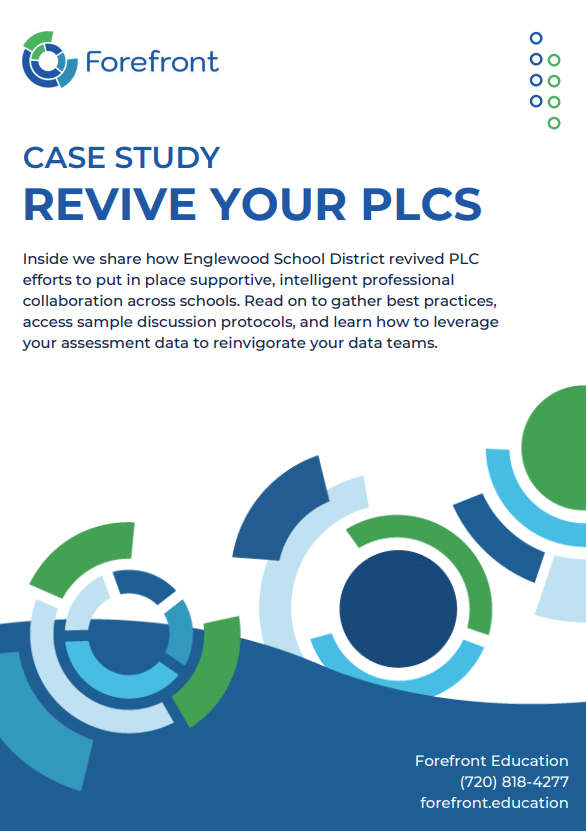Data Driven Instruction
- April 17, 2023
- Blog

Do teachers in your district think of data as a four-letter word? That’s because so much of the data that they are asked to collect and use is not meaningful or manageable. For data to inform classroom practice, it must be timely, actionable, and linked to classroom instruction. Highlighting spreadsheets, navigating confusing websites, and guessing at root causes frustrates teachers and can take up a lot of their time.
Nevertheless, data can play a critical role in improving instructional practice. When data is meaningful, actionable, and easy to interpret, data can tell powerful stories about student learning.
Background and Context
Data driven instruction (DDI) is a robust set of ongoing practices that focuses on assessing student learning, analyzing assessment data and adjusting instruction in response to the assessment data in intentional cycles (daily, weekly, etc.) Read more.
Essentially, data driven instruction will help your teachers answer the question, “Are we delivering on what we promise for our students, and what can we do to improve?” Details about these data driven instructional practices follow:
Intentionally Assess Student Learning
For data driven instruction to be effective, it is necessary to have a set of common assessments shared among grade-level and departmental teams. One scenario is to collect end-of-unit or end-of-module assessment results. Some districts ask teachers to focus on specific formative assessments. Others might choose to emphasize exit tickets or quizzes for progress monitoring through the progression of the unit. For data analysis to be valid and manageable, identical tasks, clearly defined scoring criteria (e.g. rubrics), and data accessibility are key. Additionally, the most impactful assessments are frequent and directly connected to the goals of each unit, so that instructional responses are clear.
To enhance the data and make it more meaningful, teachers should bring actual samples of student work to meetings. When there are certain ideas that need to be revisited, patterns in errors, or small groups of students needing specific support or extension/enrichment, work samples help indicate next steps.
Tip for Forefront clients: When using Forefront, you may also attach images of student work to student profiles by using the note catcher tool.
Less Can Be More
There is a common misconception that more data equals better insights, but data analysis in the post “big data” era is more about quality than quantity. Teachers can make better decisions with less data when the data is from quality assessments directly tied to instruction.
Be selective and intentional about what data you ask teachers to examine. If possible, repurpose classroom assessments for data driven instructional work. Do not add additional layers of assessment. New assessments cost time and money. Additionally, too much data does not necessarily allow for more sophisticated analyses. Instead, it quickly becomes overwhelming and frustrating for teachers. Less can be more, especially considering the work that we are asking teachers to do interpreting and evaluating this information.
If you are not currently collecting common assessment results, we recommend starting with minimal, but meaningful expectations for data collection. Identify key common assessments you wish to have teachers and leadership look at systematically for PLCs and other purposes. As a data driven culture becomes instilled, data collection expectations can become more robust.
Analyze Data Collectively
If a district has prioritized data driven instruction and PLC efforts, teachers should be provided with adequate time to connect, discuss evidence of student learning, and plan responses. Frequency, duration, and consistency are key to quality communication.
If possible, designate an instructional coach or teacher to lead the efforts at the site-level or for a grade-level. Leaders should be the first people to conduct an initial data analysis to inform meetings, and share agendas and other necessary items (e.g. slide decks, reflection sheets, report copies) in advance. This means these meetings will focus on quickly identifying student needs and planning instructional responses. Download our PLC Case Study for a sample meeting agenda that you can adapt to your needs.
When your district adopts a solution like Forefront, you minimize redundancies. Teams will spend less time finding and analyzing data and more time discussing instructional responses. Forefront supports PLC efforts by providing organized information that is easy-to-access and easy-to-interpret. Districts that have used Forefront for multiple years and/or have uploaded historic data are able to do multi-year, longitudinal analyses. This allows leaders to monitor school improvement, and teachers to preview common misunderstandings from upcoming instructional units and adapt teaching accordingly.
Sample Data Collection Protocol
-
-
-
- Assets:What successes have you seen recently? To what do you attribute those successes?
- Results: Open the Single Assessment report in Forefront for the assessment being discussed. What do you see? Reflect further on what went well.
- Reflect: Which questions/topics were most difficult for students? How did students perform on priority topics? What might have been done that could have led to greater success? This is a good time to discuss student work samples and look for patterns.
- Teach forward: What implications do the results have for upcoming unit(s)? Consider using the Standards Growth report.
- Re-Engage: Will certain topics be retaught to the whole group? Is there a need for small group, targeted instruction?
-
-
Monitor Impact of Data on Instruction
The most important premise of data driven instruction is that the assessment results referenced in data team meetings inform practice. How can you validate this? One way is to routinely observe classrooms and provide feedback to teachers.
Every interaction in a school contains an element of feedback. When feedback is intentional there is a plan in place to provide feedback that supports improvements. Incorporating this intentional feedback is an essential element of efficient learning. Provide feedback 1:1 or during collaborative time. Note that the best feedback loops are reciprocal, providing time for teachers to share their suggestions and recommendations to improve practice and the next data team meeting.
Conclusion
Data driven instruction can help transform learning outcomes for students and help teachers feel supported. When you commit to collecting assessment information intentionally, you make data meaningful and manageable for teachers. Looking at this information collectively makes your professional learning communities intelligent and supportive of all learners.
Don’t let data be a four-letter word in your districts. Fuel your grade-level teams with meaningful information about student learning. Your teachers will be more informed and less frustrated with data analysis. Most importantly, your conference rooms will be filled with thoughtful reflection, planning, and laughter.
Suggested Reading
Bambrick-Santoyo, Paul. Driven By Data 2.0: A Practical Guide to Improve Instruction. San Francisco, CA, Jossey-Bass, 2019.
4 Recommendations to Improve Your PLC Work. Forefront Education Blog.
About us and this blog
Our team and tools help schools implement standards-based grading, streamline assessment systems, and use meaningful data to drive decision-making.
Free PLC Case Study
Learn about how Forefront client Englewood School District put in place supportive, intelligent professional collaboration across schools. Download your free copy today to access best practices, view sample discussion protocols, and learn how to leverage your assessment data to reinvigorate your data teams.

More from our blog
See all postsForefront is the only assessment data solution optimized for classroom assessment results, leveraging these results to fuel instruction, PLCs, and grading. Elevate meaningful assessment data district-wide to transform how you understand and communicate about student learning across your schools.
Copyright © 2025 Forefront Education, Inc. All Rights Reserved.







